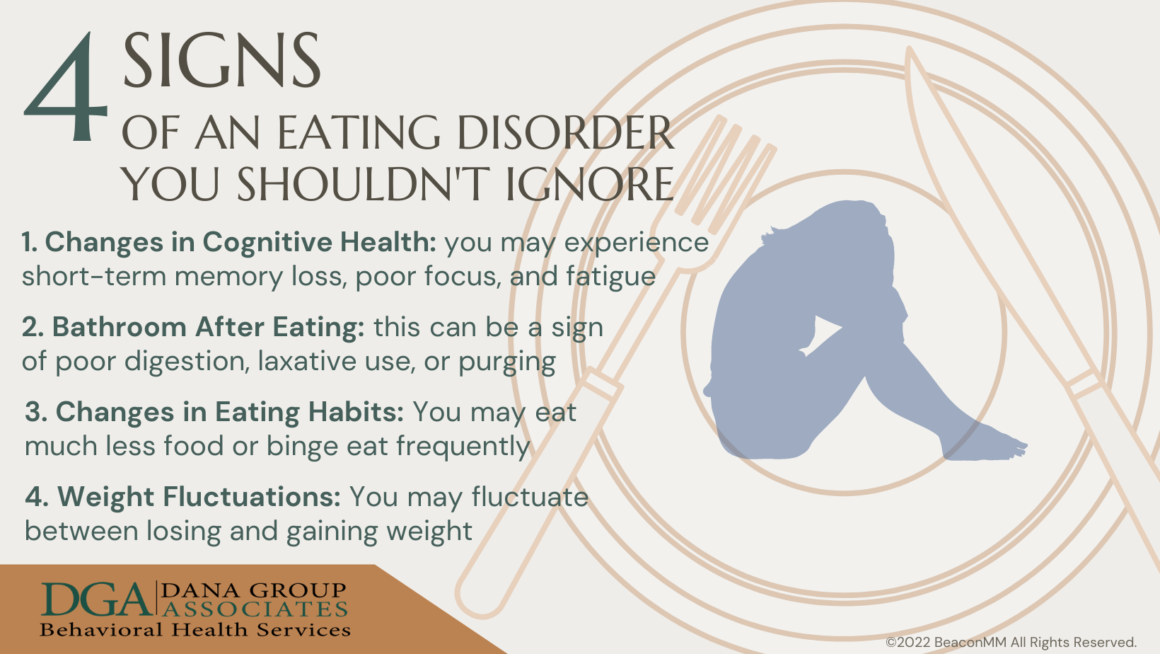When we think of eating disorders, we often picture a young girl with anorexia. However, eating disorders in adults do occur, and they can be just as severe or even fatal. Anyone can have an unhealthy concept of how to eat properly – whether young or old, male or female. Here are the main types of eating disorders and signs that tell you that you need to seek help.

Are you worried that you or a loved one has an eating disorder? Talk to a therapist at Dana Behavioral Health for an assessment and treatment.
Eating Disorders Statistics
Eating disorders can take many forms. The most common eating disorders are anorexia nervosa, bulimia nervosa, and binge-eating disorder. The following statistics are from the National Institute of Mental Health, and they represent the prevalence of each type of eating disorder in the U.S.
Binge Eating Disorder
- Males – 0.8%
- Females – 1.6%
- Age 18-29 – 1.4%
- Age 30-44 – 1.1%
- Age 45-59 – 1.5%
- Age 60+ – 0.4%
Bulimia Nervosa
- Female – 0.5%
- Males – 0.1%
- Ages 18-29 – 0.3%
- Ages 30-44 – 0.4%
- Ages 45-59 – 0.4%
- Ages 60+ – 0.1
Anorexia Nervosa
- Lifetime prevalence in adults – 0.6%
- Females – 0.9%
- Males – 0.3%
Other statistics from ANAD (the National Association of Anorexia Nervosa and Associated Disorders) show that overall, 9% of the U.S. population has some type of eating disorder. That’s 28.8 million people. What’s more, 10,200 deaths each year happen because of eating disorders.
Could you be one of the millions of Americans with an eating disorder? Connect with our counselors at Dana Behavioral Health for a professional assessment.
4 General Signs of Eating Disorders in Adults
There are many different signs for each type of eating disorder. Let’s start with a look at the general categories of symptoms you might notice in yourself or someone else if they have an eating disorder. If you have one or more of these symptoms, seek help now.
- Changes in Cognitive Health – Because eating disorders in adults keep you from getting healthy nutrition, you may experience cognitive symptoms, such as short-term memory loss, difficulty maintaining focus, and fatigue.
- Usually need to use the bathroom right after eating.
- Changes in eating behaviors. The types of changes you might notice differ with the various types of eating disorders in adults.
- Weight fluctuations – People commonly assume that people with eating disorders will always lose weight. However, the truth is that these disorders often cause fluctuating weight or even weight gain.
Specific Signs of Top Three Eating Disorders
Knowing the specific signs for each eating disorder can help you recognize which one you or someone else might have. However, it’s always best to seek help when you see the four main signs of eating disorders in adults. Your mental health provider can narrow down the diagnosis, help you with goal-setting for your mental health, and create a treatment plan. Here are the signs of binge eating, bulimia, and anorexia.
Binge Eating Disorder Symptoms
When you or someone else has any of the following symptoms, it’s time to seek help from a mental health professional.
- Frequent episodes of eating very large amounts of food
- Feeling out of control when not bingeing
- Eating when you aren’t hungry
- Eating until you are uncomfortably full
- Feeling guilt or shame when bingeing
- Eating alone, often hiding food to consume later
- Might or might not gain weight rapidly
- Eating much faster when bingeing
Binge eating disorders can cause a variety of physical health problems, especially if there’s dramatic weight gain. In this sense, binge eating disorder can be extremely dangerous. According to womenshealth.gov, if you binge at least once a week for three months, you might fit the diagnosis of binge eating disorder.
Bulimia Nervosa Signs
Bulimia nervosa, also known simply as bulimia, is an eating disorder that can occur in adults. Like people with binge eating disorder, people with bulimia eat a large amount of food very quickly. The difference is that after they eat, they do various things to try to get rid of the food, whether by self-induced vomiting, using laxatives, or exercising obsessively. They might also fast or take pills to get rid of water weight. Here are the signs to watch for if you think you might have bulimia.
- Fluctuating weight
- Bingeing and purging (throwing up or using laxatives)
- Hiding food to eat alone
- Feeling out of control while bingeing
- Feeling shame and guilt around eating
- Being obsessed with the weight and shape of your body
- Always talking about or engaging in dieting and exercise
- Signs of purging, such as going to the bathroom after most meals, swollen cheeks, discolored teeth, or cuts and scabs on the backs of their hands.
- Staying away from social activities, especially when food will be served
Anorexia Nervosa
Anorexia nervosa, commonly called anorexia, is a dangerous mental health problem. The preoccupation with food and body weight can drive people to starve themselves to the point of death. Here are the signs of an anorexia eating disorder in adults.
- Very low body weight or dramatic weight loss
- Seeing yourself as overweight, even if you are very thin
- Always denies that they’re hungry
- Weighing yourself more often than needed
- Preoccupation with the weight and shape of your body
- Talking a lot about food quality, nutrients, and calories
- Food rituals, like chewing a certain number of times or cutting food into tiny pieces
- Over-exercising and obsessive dieting
- Having anxiety about your weight
- Fatigue and weakness
- Dry or thinning hair and dry skin
- Often feel colder than others and wear many layers of clothing to stay warm
- Lanugo – a type of downy hair that covers your body
- In women, menstruation stops
Do these symptoms of eating disorders sound too familiar? Contact Dana Behavioral Health to begin treatment with a team that cares.
Treatment for Eating Disorders in Adults
Each of these eating disorders, as well as others, presents a danger to your health and well-being. Yet, successful treatment can help you feel better about yourself and change the way you approach eating. In fact, getting the right help might save your life.
With all this talk of food and eating, you might assume that treatment for eating disorders in adults is all about food. Yes, you will need to learn better eating habits. However, you’ll also receive help in unraveling the underlying mental health issues that affect the way you eat. For example, low self-esteem, stress, unrealistic expectations, and other issues can have an impact.
Where to Get Help for Eating Disorders in Adults
Finding help for eating disorders in adults is the first step to freeing yourself of your condition.
At Dana Behavioral Health, we want to facilitate your recovery from mental health problems like eating disorders. If you are in crisis, you can find immediate help. Our Resources Page offers several crisis hotlines. Helplines generally deal with the crisis at hand and offer resources, but they don’t provide ongoing support or treatment.
For the treatment you will need, you can go to a local mental health provider with experience and an understanding of eating disorders in adults. If you are in or near Massachusetts, we invite you to contact us at Dana Behavioral Health Behavioral Health Services. We can provide the treatment needed for anorexia, bulimia, binge eating, or any other eating disorder. Fortunately for many people with eating disorders, treatment paves the way for a happier, healthier life. There’s no better time to take control of your eating disorder and your life than right now.
Are you ready to put your eating disorder behind you? Start the journey today by scheduling an appointment at Dana Behavioral Health.
